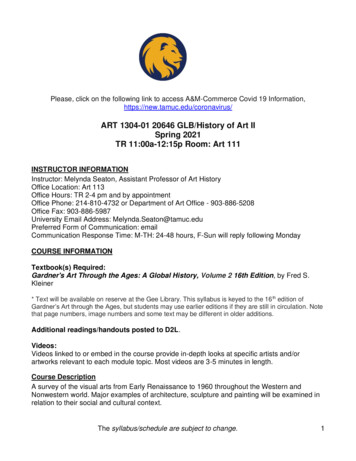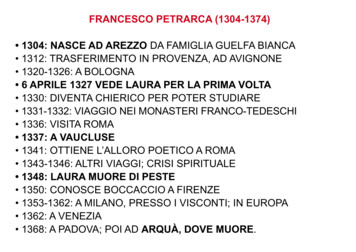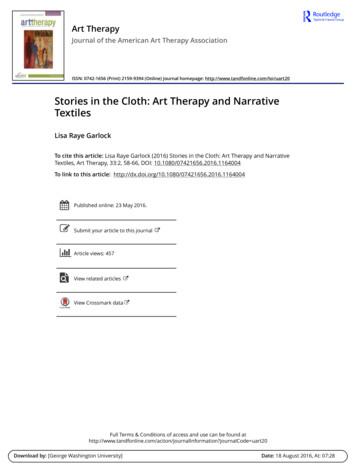
Transcription
Please, click on the following link to access A&M-Commerce Covid 19 Information,https://new.tamuc.edu/coronavirus/ART 1304-01 20646 GLB/History of Art IISpring 2021TR 11:00a-12:15p Room: Art 111INSTRUCTOR INFORMATIONInstructor: Melynda Seaton, Assistant Professor of Art HistoryOffice Location: Art 113Office Hours: TR 2-4 pm and by appointmentOffice Phone: 214-810-4732 or Department of Art Office - 903-886-5208Office Fax: 903-886-5987University Email Address: Melynda.Seaton@tamuc.eduPreferred Form of Communication: emailCommunication Response Time: M-TH: 24-48 hours, F-Sun will reply following MondayCOURSE INFORMATIONTextbook(s) Required:Gardner's Art Through the Ages: A Global History, Volume 2 16th Edition, by Fred S.Kleiner* Text will be available on reserve at the Gee Library. This syllabus is keyed to the 16 th edition ofGardner’s Art through the Ages, but students may use earlier editions if they are still in circulation. Notethat page numbers, image numbers and some text may be different in older additions.Additional readings/handouts posted to D2L.Videos:Videos linked to or embed in the course provide in-depth looks at specific artists and/orartworks relevant to each module topic. Most videos are 3-5 minutes in length.Course DescriptionA survey of the visual arts from Early Renaissance to 1960 throughout the Western andNonwestern world. Major examples of architecture, sculpture and painting will be examined inrelation to their social and cultural context.The syllabus/schedule are subject to change.1
Student Learning Outcomes:1. To gain an understanding of the visual arts as an expression of human insight, imagination,and technological achievement.2. To see the ways in which art reflects or communicates social, political, ideological, andreligious values and constructions.3. To understand the development of the visual arts against the patterns and chronology ofhuman history.4. To learn themes and meanings embodied in works of art.5. To recognize the interconnections between art and other expressions of human activity,such as literature, science, economics, music, and theatre.Minimal Technical Skills NeededUsing D2L Brightspace learning management system, Microsoft Word, Microsoft PowerPoint,or Google Slides.Course Instruction Methods and Student Expectations:This course will require both reading material located in the D2L classroom, weekly readingassignments from the course textbook, and attending in-class lectures. Assignments willinclude visual style guides and exams.COURSE REQUIREMENTSGradingFinal grades in this course will be based on the following scale:A 90%-100%A 540 – 600 PointsB 80%-89%B 480 – 539 PointsC 70%-79%ORC 420 – 479 PointsD 60%-69%D 360 – 419 PointsF 59% or BelowF 359 & PointsAssessmentsStyle Guides – 4 @ 50 pts 200 ptsExams – 4 @ 100 pts each 400 ptsTotal Points – 600Course Policies:Style Guides: Late submissions will receive a ½ letter grade deduction for each day submittedlate and will not be accepted after three (3) days past deadline. See course schedule for styleguide deadlines.Missed Exams: If you miss an exam for any reason you will be permitted to take acomprehensive make-up given on the last day of class or you may also take thecomprehensive make-up to replace a grade on one of your other tests.The syllabus/schedule are subject to change.2
Attendance: Regular class attendance is expected. It is the responsibility of each student tomonitor his/her attendance. If illness or personal/family emergency prevents you fromattending, please notify me as soon as possible about your absence.Each student in this course is allowed unexcused absences amounting to three class periods.Unexcused absences require no explanation on the part of the student. In this class, excusedabsences are normally (1) participation in pre-approved University activities such as athleticevents, sponsored field trips, and travel for specific University-related academic reasons; (2)verifiable legal proceedings; and (3) cases of illness, injury, or emergencies. For any absencesto be considered excused, illness or otherwise, email your professor prior to the missed classwith details of reason for absence. Failure to communicate with professor will result in anunexcused absence. When a student accrues more than three unexcused absences theinstructor has the prerogative to drop the student 1 letter grade for each unexcused absenceexceeding 3. For example, 4 unexcused absences will drop an “A” to a “B” and so forth.Note: It is the student’s responsibility to insure you sign the attendance sheet eachclass. If your signature is not on the sign-in sheet, you are considered absent.Academic dishonesty:There is zero tolerance for academic dishonesty in this class. Be sure that you understandwhat constitutes academic dishonesty (e.g., plagiarism, cheating on exams, theft ofinstructional material or exams, representing the work of someone else as one’s own, etc.).Academic dishonesty is a severe transgression in college and may result in referral to theDean of Students, dismissal from class, expulsion from the University, and a failing grade.Classroom Etiquette:Please be mindful and respectful of others in the classroom. In all communication includingemail and discussion groups please adhere to the following guidelines: Use of profanity, slang or racial slurs is NOT permitted Be mindful of tone, keep it professional and respectful of others Avoid jokes, as they may not come across as such by othersAny behavior that is deemed disruptive by the instructor may result in a student being asked toleave class, and continued disruptions may also result in expulsion from the class.Interaction with Instructor StatementEmail is the quickest and most reliable way to contact me at melynda.seaton@tamuc.edu and Iwill conduct email correspondence according to the following schedule: Monday–Thursday: Every effort will be made to answer your emails within a 24-48-hourperiod. Friday–Sunday: I will try to answer your emails in a timely manner, but pleaseunderstand you may not receive a response until the following Monday or Tuesday.You may also contact me at 214-810-4732. If you wish to call, please be mindful of the timeand only call during normal business hours Monday – Thursday, 8 am – 5 pm.Please feel free to contact me with any questions or concerns you may have.If you encounter problems accessing D2L, please contact Technical Support at 1-877-3257778.The syllabus/schedule are subject to change.3
TECHNOLOGY REQUIREMENTSLMSAll course sections offered by Texas A&M University-Commerce have a corresponding courseshell in the myLeo Online Learning Management System (LMS). Below are technicalrequirementsLMS rticle/Brightspace-Platform-RequirementsLMS Browser rightspace/requirements/all/browser support.htmYouSeeU Virtual Classroom ESS AND NAVIGATIONYou will need your campus-wide ID (CWID) and password to log into the course. If you do notknow your CWID or have forgotten your password, contact the Center for IT Excellence (CITE)at 903.468.6000 or helpdesk@tamuc.edu.Note: Personal computer and internet connection problems do not excuse the requirement tocomplete all course work in a timely and satisfactory manner. Each student needs to have abackup method to deal with these inevitable problems. These methods might include theavailability of a backup PC at home or work, the temporary use of a computer at a friend’shome, the local library, office service companies, Starbucks, a TAMUC campus open computerlab, etc.COMMUNICATION AND SUPPORTIf you have any questions or are having difficulties with the course material, please contactyour Instructor.Technical SupportIf you are having technical difficulty with any part of Brightspace, pleasecontact Brightspace Technical Support at 1-877-325-7778. Other support options can befound ontactsupportUNIVERSITY PROCEDURES/POLICIESSyllabus Change PolicyThe syllabus is a guide. Circumstances and events, such as student progress, may make itnecessary for the instructor to modify the syllabus during the semester. Any changes made tothe syllabus will be announced in advance.The syllabus/schedule are subject to change.4
University Specific ProceduresStudent ConductAll students enrolled at the University shall follow the tenets of common decency andacceptable behavior conducive to a positive learning environment. The Code of StudentConduct is described in detail in the Student tudents should also consult the Rules of Netiquette for more information regarding how tointeract with students in an online forum: https://www.britannica.com/topic/netiquetteTAMUC AttendanceFor more information about the attendance policy please visit the Attendance webpage andProcedure 99.R0.01.pdfAcademic IntegrityStudents at Texas A&M University-Commerce are expected to maintain high standards ofintegrity and honesty in all of their scholastic work. For more details and the definition ofacademic dishonesty see the following procedures:Undergraduate Academic Dishonesty AcademicDishonesty.pdfGraduate Student Academic Dishonesty emicDishonesty.pdfStudents with Disabilities–ADA StatementThe Americans with Disabilities Act (ADA) is a federal anti-discrimination statute that providescomprehensive civil rights protection for persons with disabilities. Among other things, thislegislation requires that all students with disabilities be guaranteed a learning environment thatprovides for reasonable accommodation of their disabilities. If you have a disability requiring anaccommodation, please contact:Office of Student Disability Resources and ServicesTexas A&M University-CommerceThe syllabus/schedule are subject to change.5
Gee Library- Room 162Phone (903) 886-5150 or (903) 886-5835Fax (903) 468-8148Email: studentdisabilityservices@tamuc.eduWebsite: Office of Student Disability Resources and rimination NoticeTexas A&M University-Commerce will comply in the classroom, and in online courses, with allfederal and state laws prohibiting discrimination and related retaliation on the basis of race,color, religion, sex, national origin, disability, age, genetic information or veteran status.Further, an environment free from discrimination on the basis of sexual orientation, genderidentity, or gender expression will be maintained.Campus Concealed Carry StatementTexas Senate Bill – 11 (Government Code 411.2031, et al.) authorizes the carrying of aconcealed handgun in Texas A&M University-Commerce buildings only by persons who havebeen issued and are in possession of a Texas License to Carry a Handgun. Qualified lawenforcement officers or those who are otherwise authorized to carry a concealed handgun inthe State of Texas are also permitted to do so. Pursuant to Penal Code (PC) 46.035 and A&MCommerce Rule 34.06.02.R1, license holders may not carry a concealed handgun in restrictedlocations.For a list of locations, please refer to the Carrying Concealed Handguns On Campusdocument and/or consult your event organizer.Web loyeesAndStudents/34.06.02.R1.pdfPursuant to PC 46.035, the open carrying of handguns is prohibited on all A&M-Commercecampuses. Report violations to the University Police Department at 903-886-5868 or 9-1-1.Pandemic Response StatementsA&M-Commerce requires the use of face-coverings in all instructional and researchclassrooms/laboratories. Exceptions may be made by faculty where warranted. Faculty havemanagement over their classrooms. Students not using face-coverings can be required toleave class. Repetitive refusal to comply can be reported to the Office of Students’ Rights andResponsibilities as a violation of the student Code of Conduct.Students should not attend class when ill or after exposure to anyone with a communicableillness. Communicate such instances directly with your instructor. Faculty will work to supportthe student getting access to missed content or completing missed assignments.The syllabus/schedule are subject to change.6
DateTopicReading (16th ed.)Jan. 12Intro to CourseIntroductionJan. 1415th Century Northern EuropeChapter 20Jan. 1915thChapter 21Jan. 2116th Century Italy – High Renaissance and MannerismChapter 22Jan. 2616thCentury Italy – High Renaissance and MannerismChapter 22Jan. 2816th Century Northern Europe & Spain – Style Guide 1 DueChapter 23Feb. 2Exam 1Feb. 4The Baroque in Italy and SpainChapter 24Feb. 9The Baroque in North EuropeChapter 25Feb. 11Rococo Art, Natural Art, and NeoclassicismChapter 26Feb. 16NeoclassicismChapter 26Feb. 18RomanticismChapter 27Feb. 23Realism and PhotographyChapter 27Feb. 25Victorian Architecture – Style Guide 2 DueChapter 28Mar. 2Exam 2Mar. 4South and Southeast Asia from 1200Chapters 33Mar. 9ChinaChapter 34Mar. 11JapanChapter 35Mar. 16Native Arts of the Americas after 1300Chapter 36Mar. 18OceaniaChapter 37Mar. 23African Art – Style Guide 3 DueChapter 38Mar. 25Exam 3Mar. 30Impressionism & Post-ImpressionismChapter 28Apr. 1Symbolism & Late 19th Century ArchitectureChapter 28Apr. 6European Art – 1900- 1945Chapter 29Apr. 8European and American Art – 1900- 1945Chapters 29 & 30Apr. 13American Art – 1900- 1945Chapter 30Apr. 15European and American Architecture – 1900 - 1980Chapter 29 & 30Apr. 20European and American Art – 1945-1980Chapter 31Apr. 22European and American Art – 1945 -1980 – Style Guide 4 DueChapter 31Apr. 26-30Exam 4Century Italy – Early RenaissanceThe syllabus/schedule are subject to change.
Gardner's Art Through the Ages: A Global History, Volume 2 16th Edition, by Fred S. Kleiner * Text will be available on reserve at the Gee Library. This syllabus is keyed to the 16th edition of Gardner's Art through the Ages, but students may use earlier editions if they are still in circulation. Note









